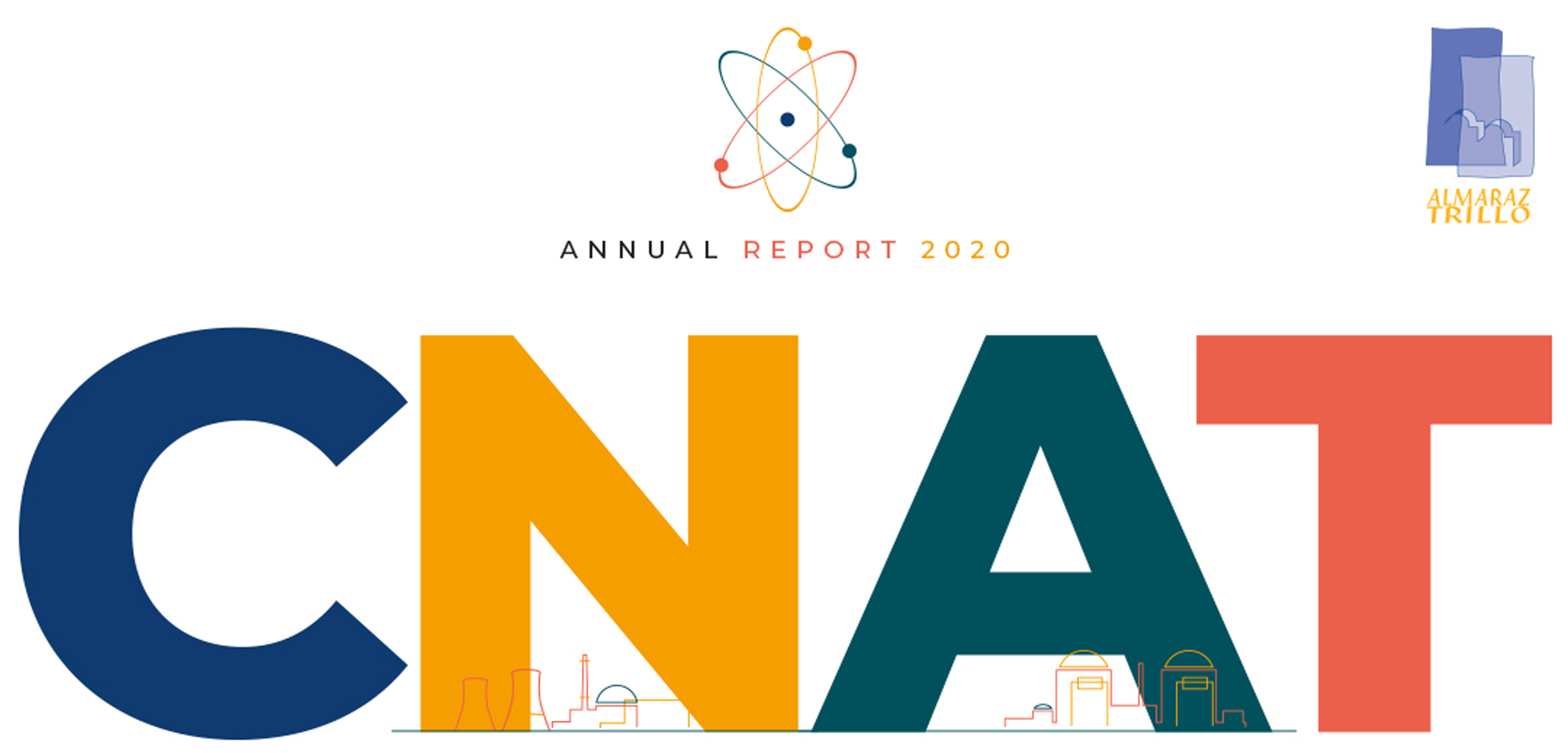

OPERATIONS
Almaraz power plant
The gross production generated between the two units of the Almaraz nuclear power plant at the end of 2020 was 15,890.7 GWh and the joint net production was 15,279 GWh. The gross electricity production corresponding to Unit I was 7,161.3 GWh and that corresponding to Unit II was 8,729.4 GWh. The Almaraz utility has an accumulated gross electricity production at origin of 561,527.308 GWh (282,406.506 GWh for Unit I and 279,120.802 GWh for Unit II).
Unit I has been operating stably throughout the period, except at the beginning of March, when the load was lowered at the request of the Central Generation Dispatch for Flexible Operation. On 22 June 2020, Unit I suffered an automatic reactor shutdown as a result of the turbine protections triggered by the electrical generator. This shutdown did not pose any risk to the population or the environment. The 27th refuelling outage began on April 14th and continued until June 21.
Unit II has been operating stably throughout the period, except in the months of March, April and May, when at the request of the Central Generation Dispatch it was downgraded for Flexible Operation. On 27 June 2020, Unit II suffered an automatic reactor shutdown as a result of the unexpected opening of one of the circuit breakers of the automatic shutdown system. This shutdown did not pose any risk to the population nor to the environment.
In 2020 the Almaraz nuclear power plant reported 5 reportable events to the nuclear authority Nuclear Safety Council (CSN). The annual drill of the Site Emergency Plan (SEP) was carried out on 10th December, an exercise that has been developed taking into account the measures established due to the pandemic caused by Covid-19.
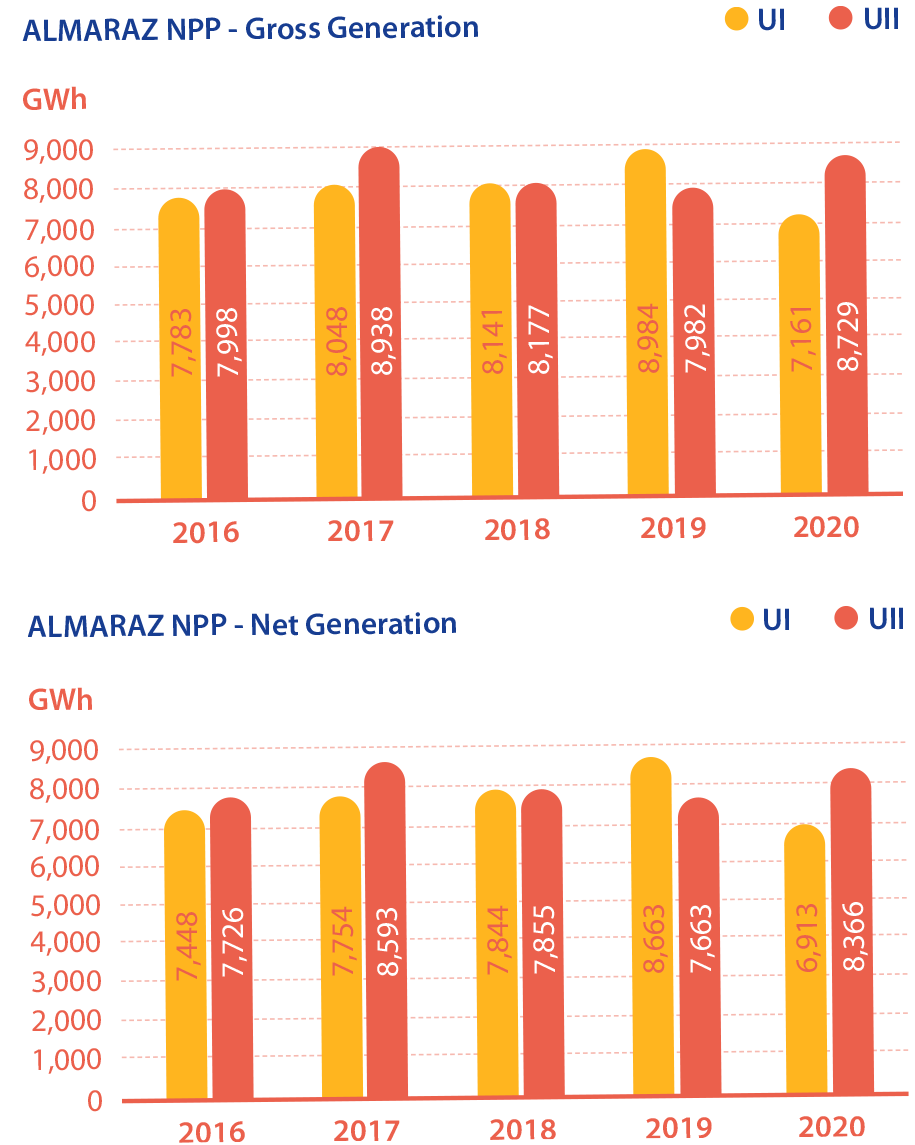

Trillo plant
During 2020, the Trillo nuclear power plant generated 8,275.82 GWh of gross electricity and 7,729.61 GWh of net electricity. It has an accumulated gross electricity production since the start of commercial operation of 264,024.77 GWh, a total of 253,015.2 hours coupled to the grid and 13 consecutive years without automatic reactor shutdowns.
The Trillo nuclear power plant has operated stably throughout the year, except in the months of February, March and April, when, at the request of the Central Generation Office, the load was reduced due to Flexible Operation. On 18th May, the thirty-second annual refueling and maintenance outage began and was completed on 20th June.
In 2020 Trillo NPP reported 1 reportable event to the CSN. The annual Site Emergency Plan (SEP) drill was carried out on 19th November, for which a scenario was designed in which the emergency level reached Category III “Site Emergency”.
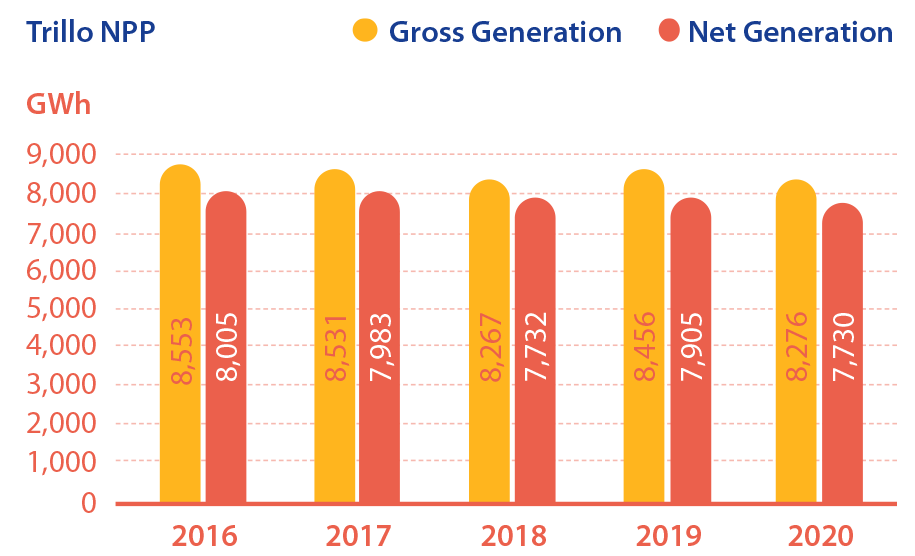

REFUELLING OUTAGES
Almaraz Power Plant
On 14th April, the first phase of the 27th reloading began in the Unit-I with a smaller scope than usual. Subsequently, following analysis of the evolution of the pandemic caused by COVID-19 and the satisfactory performance of the scheduled activities, the CNAT Management decided to adapt the planning and continue the work initially foreseen, maintaining the highest levels of accident prevention, nuclear safety and radiation protection. This refuelling outage lasted 67 days, much longer than usual and with a lower number of contracts in order to guarantee the protection of all the workers against COVID-19, the use of all the established protections, the sanitisation measures implemented and the limitation of the gathering of personnel at the Plant being mandatory.
Among the most relevant activities carried out during the shutdown of CNA 1 were the Eddy-current tests of the 3 steam generators, the ultrasonic inspection of the vessel, the revision of seals in the cooling pump of reactor number 3, the replacement of 3 safety valves of the Pressuriser, the maintenance of main turbine valves and the replacement of the number 2 charge pump motor.
Trillo NPP
The 32nd refuelling and general maintenance outage of Trillo NPP took place between 18th of May and 20th of June. It lasted longer than usual, 34 days, in order to guarantee protection against COVID 19 for all workers. After analysing different scenarios and always with the aim of protecting the health of workers against possible contagion, the decision was taken to delay the outage until the 18th of May. This re-planning made it possible to minimise the parallel execution of the work, maintaining the staggered entry of personnel into the plant, the use of the established protections, as well as the defined sanitation measures. In addition, the concurrence of personnel in the plant was minimised so that no more than 800 people coincided at any time, including staff, collaborating companies and additional workers, in order to avoid occupational hazards.
Among the activities carried out were the Eddy-current inspection of 100% of the tubes of a steam generator, the inspection of seals and revision of the lower radial bearing in a main cooling pump and the preventive replacement of the motor in another of the pumps, and the cleaning and inspection of the essential services water pool.
RADIOLOGICAL SAFETY AND PROTECTION
The operation of the facilities during 2020 has been completely normal, with no significant incidents affecting nuclear safety and radiation protection, either for employees or for the plant environment.
In the case of the Almaraz plant, the collective dose of the personnel was 415 mSv per person for the two units overall, and at the Trillo plant the dose was 256.48 mSv per person. The results obtained from the measurements performed show a dose for professionally exposed personnel that is once again far below the legally established limits.
TECHNOLOGICAL UPDATING
During 2020, CNAT has continued with the planned investment schedule framed within the process it has been carrying out in recent years to improve safety, as well as to maintain the availability of the plants by renewing their equipment due to obsolescence.
At Almaraz Nuclear Power Plant
• Modernisation of the Crossflow system (ultrasonic flow measurement - UTM) in U1 has been completed, improving the configuration and noise filtering.
• Continued renewal of qualified life safety instrumentation (I&C systems subject to ICA).
• Improvements have been made to bring the Hydrazine and Ammonia tanks into compliance with the Chemical Storage Regulations (APQ) and the sulphuric and soda tanks are due to be upgraded in 2021.
• TThe first phase of motorised valve actuators (SMA) has been replaced by SMB actuators. The U1 actuators were replaced in 2020 (in RO-127) and the U2 actuators are planned to be replaced in 2021 (in RO-226).
• The new water treatment system based on EDI technologie (electrodeionisation) has been commissioned to replace the current physico-chemical demineralisation chain (resin recombiners), improving the production capacity of demineralised water.
• The medium-voltage safety electric motors renewal plan (REMSE) continues. Under this plan, electric motors that have accumulated a high number of operating hours (>200,000h) are being renewed. In 2020, the 4 motors of the CS and CC system of Unit-1 and 2 motors of Unit-2 have been installed. The remaining two Unit-2 motors will be installed in 2021. In addition, an online partial discharge measurement system has been installed on 6.3 kV motors to monitor the status of the rest of the motors in order to take action based on the results.
• The renovation of the meteorological tower has been completed, where all the input sensors have been renewed, as well as the data acquisition computer system (which was obsolete).
• The seismic instrumentation computer has been renewed.
• The Almaraz simulator has been transferred from the Tecnatom facilities at San Sebastián de los Reyes. Start-up will take place in the first quarter of 2021.
• The replacement of low-voltage circuit breakers continues (the HFB model is replaced by HFD) and medium-voltage circuit breakers, with the OTOMAX and NOVOMAX models being replaced by the EMAX model.
At Trillo Nuclear Power Plant
• The H&B actuator modernisation project continues, having completed the Nuclear Safety actuator environmental qualification in 2020, as well as the designs required for implementation in 2021.
• The upgrading of electronic boards and the purchase of additional stock continues.
• The renewal of the control of the decontamination system for equipment related to the TU-50 primary pumps has been completed.
• The designs have been developed for the project to modernise the voltage regulation and power stabilisation systems of the main generator at the plant, scheduled to be implemented in RO-433 refuelling outage in 2021.
• The renovation of the 15 kV medium-voltage ring main facilities has continued with the commissioning of a new medium-voltage transformer station, with the full scheduled scope to be completed in the first quarter of 2021.
• The new Generation circuit breaker has been awarded and designs have begun for its replacement in the RO-434 refueling outage (2022) due to the obsolescence of the current circuit breaker and as part of the Plant’s Equipment Renewal Plan.
• The purchase of pumps for the UF, RS, UT and RN systems, affected by obsolescence, has been launched.
• For reliability improvement reasons, a new TA system exchanger (TA11B001) has been purchased and is planned to be installed in the 2021 refuelling outage.
• The strategic plan for the renewal of the diesel generators (safeguard and emergency motors and alternators) has been launched, with a view to their operation until the end of the plant’s life. The scheduled maintenance extends to 2032, and includes in its scope the major maintenance to be carried out on the equipment, with the necessary spare parts, which re-qualify these equipment for the new period.
• A new system for inerting the H2 in the alternator with argon has been installed.
• Emptying, inspection and repair of ZU2 and ZU3 swimming pools have been carried out.
• New waste oil treatment equipment has been installed in the ZC building.
• The process of refurbishing chemical analysers and other instruments has been continued.
• Modernisation of the seismic instrumentation system computer was completed.
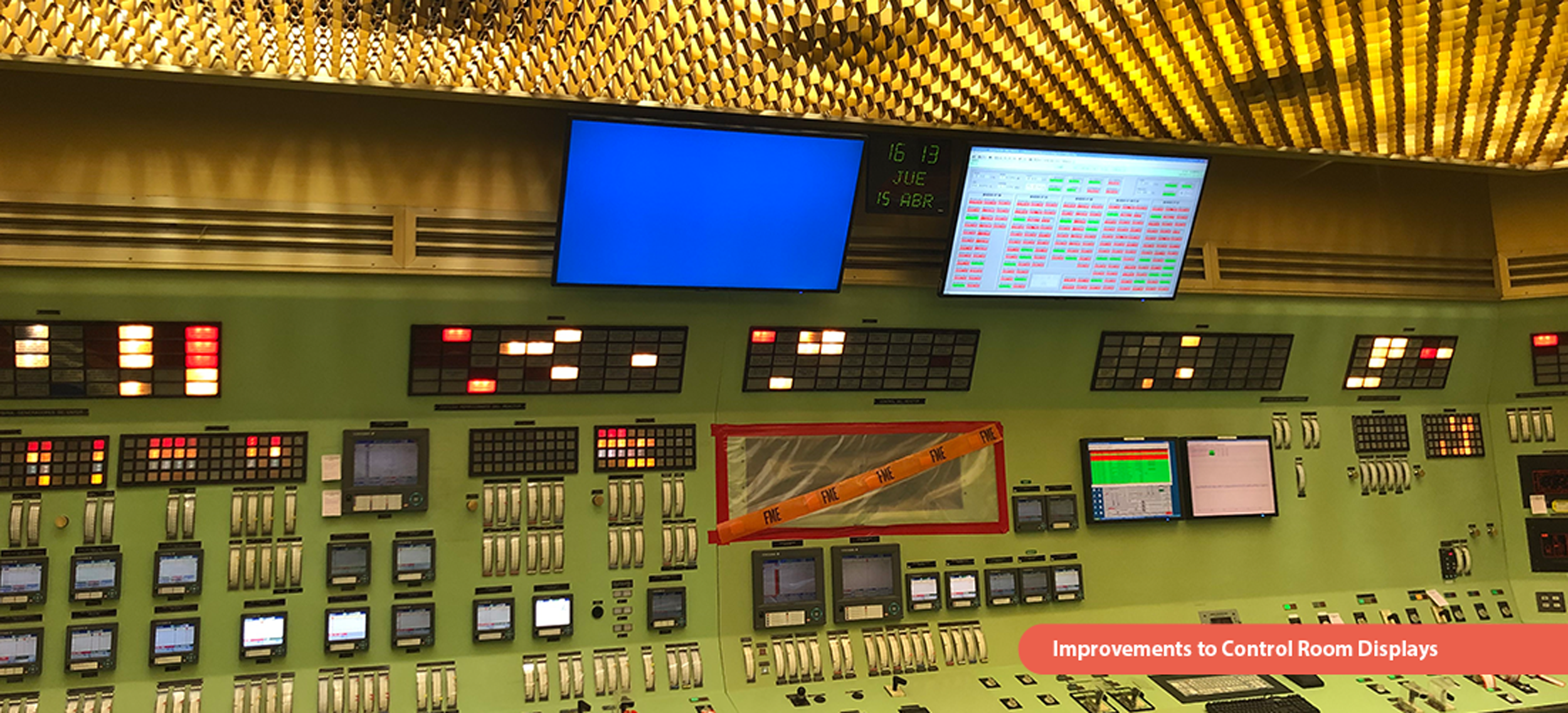
The activities associated with safety improvements include the following:
At Almaraz Nuclear Power Plant
• In 2020 the designs of the improvement proposals included in the RPS related to the Renewal of the Operating Permit for Almaraz NPP have been published. Among them, the following stand out:
• Improvements to increase the available margin in the CC system (new exchanger cleaning system, placement of HR and CS pump coolers).
• The new passive seals for the primary pumps.
• In 2020 and as part of the actions for the transition to the fire protection standard (NFPA 805), design modifications have been implemented, among which the following stand out:
• Replacement of ceramic blankets with approved passive protection RF60 in the auxiliary building (elevations +1,000, +7,300 and +14,600).
• Designs have been edited for the installation of the dual-plumbing of the containment fire protection system and improvements to the hose posts.
• Installation of detection systems in outdoor halls that are not regularly visited.
• Design of improvements in Control Room screens for Fire Monitoring (to be installed in 2021).
• As a result of the implementation of new standards and amendments to existing standards affecting the activity of the nuclear industry, the transition to ETFM (Enhanced Technical Specifications for Operation) according to NUREG-1431 in 2020 is of particular importance. At Trillo Nuclear Power Plant
• Work has continued on activities relating to the Regulator (CSN) Technical Instruction (derived from the requirements of GL2008-01), in relation to the prevention and elimination of the accumulation of gases in piping. Modifications have been made during the refueling outage, with phase 1 implementation period foreseen for 2019-2021, in accordance with the criteria of the NEI 09-10 guide. Common to both plants
• As part of the activities for compliance with ITC-14 of the Operating Permit (Adaptation of systems and equipment for testing to RG-1.140), the dampers of the TL-19/22 ventilation systems have been replaced to improve the tightness of these systems.
• The sectorisation in fire areas of the roof of the building housing the backup diesel generators has been completed, finalising the actions required to comply with IS-30 Rev.2 issued by the CSN.
• In 2020, the loading of ENUN 32P containers has continued at both plants and relicensing activities of the Independent Spent Fuel Storage Installation (ISFSI) of Almaraz NPP and Trillo NPP have been carried out in accordance with the new revision of the safety study of the new ENUN32P container.
• Phase I of the Seismic Characterisation of the plants (Seismic CTI) has been completed, in which the event data sheets have been prepared and from which the calculations that will allow the required hazard curves to be obtained are being developed.
• In the framework of the Long Term Operation, within the Nuclear Forum, the definition of cable ageing tests has been carried out in order to determine the long-term ageing of the cables and to determine renewal needs.
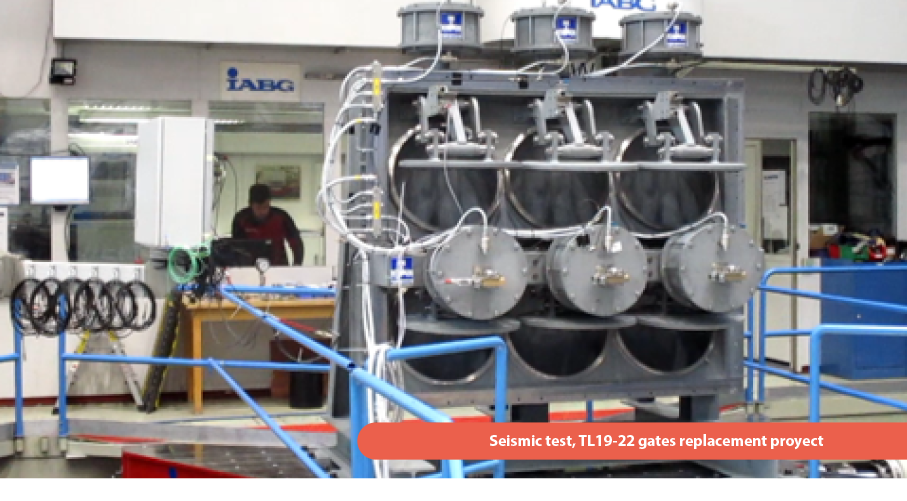
QUALITY
At CNAT, quality is intrinsic to all its activities and is the main source of confidence for our owners, social environment, workers and collaborating companies. Since 1995, CNAT’s commitment to quality has been recognised by the Spanish Association for Standardisation (AENOR) through the award of the official certificate, which accredits compliance of our Quality Management System with the UNE EN ISO 9001:2015 standard for the production of electricity from nuclear energy. In 2020, AENOR carried out a follow-up audit of the certification with a satisfactory result. We also comply with the quality standard of reference in the nuclear sector, the UNE 73401 on Quality Assurance in nuclear facilities, which is the basis of our Quality Assurance Manual, the requirements of which are permanently audited by the Nuclear Safety Council (CSN).
We also voluntarily request international evaluations to assess the organisation’s level of excellence. These include the WANO (World Association of Nuclear Operators) Peer Review, an independent assessment by a group of international experts. In January 2020, a WANO team made up of experienced professionals from 9 different countries carried out a Peer Review at Almaraz NPP, obtaining very satisfactory overall results.
WANO Member Support Missions (MSM) are also requested, in which specific aspects are assessed with reference to industry best practice, as was the case in 2020 with the Performance Improvement MSM, carried out at the three sites, identifying recommendations for improvement in the areas of Operational Experience and the Corrective Action Programme.
Continuous Improvement is part of CNAT’s organisational culture, which is why we manage around 5,000 corrective and improvement actions every year, the origin of which is both external evaluation and independent internal evaluation (Quality Assurance audits and inspections and specific evaluations and other Nuclear Supervision activities), as well as self-evaluation by the units themselves of their activities and processes. On the other hand, trend analyses of low-level incidents are performed, allowing for the identification of preventive actions to avoid more significant incidents.




